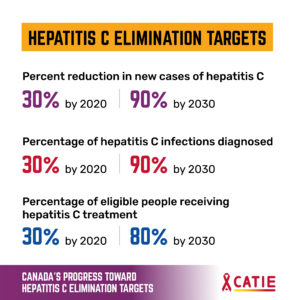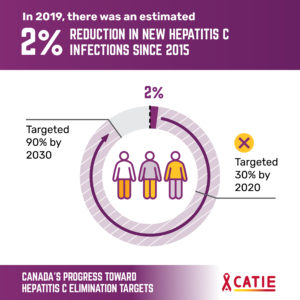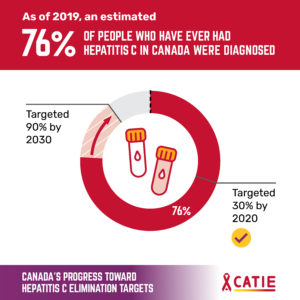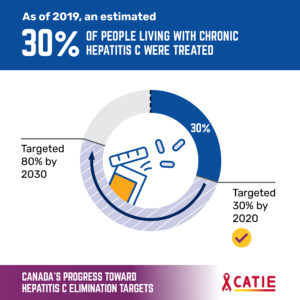New Canadian hepatitis C estimates tell us how far we’ve come (and how far we have to go)

Canada has joined countries around the world in committing to eliminate hepatitis C as a public health threat by 2030. However, how do we know if we’re on track to reach that goal and how do we measure our progress along the way?
Fortunately, the World Health Organization established targets in its Global Health Sector Strategy on Viral Hepatitis, which have been adapted to the Canadian context by the Public Health Agency of Canada (PHAC). These targets lay out a path to elimination with concrete objectives, that include a 90% reduction in new hepatitis C infections by 2030, as well as diagnosing 90% of hepatitis C infections and ensuring 80% of eligible people receive hepatitis C treatment. Each of these targets also includes a 2020 milestone, which can be used to evaluate our progress.

Where is Canada on the road to eliminate hepatitis C?
PHAC recently released Canadian hepatitis C estimates based on 2019 data, which are being used for the first time to track Canada’s progress towards our elimination targets in the areas of prevention, testing and treatment.
The estimates show that we have a lot to celebrate and a lot to coordinate and implement. Canada met its 2020 targets for testing and treatment, but we have fallen dramatically behind in preventing new infections. The 2020 target was a 30% reduction in new infections; however, between 2015 and 2019 there was only a 2% reduction in new infections.
In order to meet prevention targets, we need to maintain our momentum in testing and treatment, as well as significantly scale up prevention efforts, including bolstering harm reduction services to reduce new hepatitis C infections.
Using data as a tool to help eliminate hepatitis C in Canada
Hepatitis C elimination efforts are informed by epidemiological data. Without this data, service providers, program designers, policy-makers and funders lack critical information to help keep us on track towards elimination.
PHAC has the mandate to promote and protect the health of Canadians through leadership, partnership, innovation and action in public health, which includes collecting pan-Canadian data to inform future prevention, testing and treatment efforts. PHAC’s latest hepatitis C estimates provide a picture of hepatitis C incidence, prevalence and treatment across Canada. The previous written report of estimates released by PHAC reflect 2011 data, which – to many working in the field – could be considered a whole different era of hepatitis C work. These estimates were from a time before hepatitis C could be cured with direct-acting antivirals, before these treatments were universally covered in Canada, and well before many of the innovations led by people working in hepatitis C.
What do we mean by elimination as a public health threat?
The global efforts underway focus on eliminating hepatitis C as a public health threat, which is different than eradicating hepatitis C.
Eradication is when there are no new infections caused by a specific virus at the global level. Smallpox is a good example of a disease that was eradicated through large-scale vaccination efforts.
Technically speaking, elimination is when there are no new infections caused by a specific virus within a defined geographic area. Elimination as a public health threat refers to reducing new infections caused by a virus within a defined geographic area to the point that it is no longer considered a threat to public health within that area. Elimination as a public health threat is achieved through prevention, testing and treatment, and requires ongoing and intentional efforts to maintain. It is not currently possible to eradicate hepatitis C because there is not yet an effective vaccine, but it can be eliminated as a public health threat through curative treatments and prevention efforts. Achieving and maintaining elimination as a public health threat will always require a deliberate effort, particularly when it comes to prevention of new infections.
There is still a long way to go to eliminate hepatitis C by 2030
It is clear from this data that increased efforts to prevent new hepatitis C infections are critically needed, which includes ensuring access to essential harm reduction services and supplies. While testing and treatment targets were on track in 2019, the COVID-19 pandemic impacted access to testing and treatment for viral infections including hepatitis C. Pan-Canadian data is vital for the big picture, but it can obscure regional or local differences: an article published in the Canadian Liver Journal projected the timing of elimination of hepatitis C in the 10 provinces of Canada, and based on this analysis, the authors determined that three provinces were off track to reach elimination by 2030.
As the threat of COVID-19 begins to ease, promising pan-Canadian conversations about hepatitis C elimination have been reinvigorated. The development of regional policy and practice roadmaps for hepatitis C elimination are underway in several regions, including a recent launch of recommendations for Ontario. These conversations will focus on how elimination goals in prevention, testing and treatment can be reached, and will likely include important calls to action on how we can continue to improve our national and regional response to hepatitis C.
By emphasizing the importance of data that is timely, accurate and representative of all people living in Canada, especially populations with a higher burden of hepatitis C, the road ahead continues to become more and more clear. Equipped with the latest Canadian estimates and a set of concrete and realizable targets, we are better informed than ever about how to achieve our goal of eliminating hepatitis C in Canada.
Resources:
- National Hepatitis C estimates: Incidence, prevalence, undiagnosed proportion and treatment
- People Living with Hepatitis C (PHAC infographic)
- Hepatitis C in Canada (CATE infographic)
- Canada’s progress towards hepatitis C elimination targets (CATIE infographic)
- Hepatitis C in Canada: What do the data tell us? (Recording of CATIE, CanHepC and PHAC partnered webinar)
Melisa Dickie is Director, Hepatitis C and Harm Reduction Knowledge Mobilization at CATIE.
Shannon Elliot was CATIE’s knowledge specialist in hepatitis C and recently became senior analyst, health policy at Ontario Health (Cancer Care Ontario).



